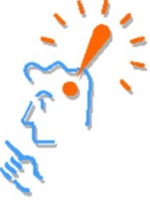Difference between revisions of "Exclamation"
m (moved Exclaimation to Exclamation: spelling) |
m (Text replacement - "http://" to "https://") |
||
| Line 3: | Line 3: | ||
==Origin== | ==Origin== | ||
French exclamer, < [[Latin]] ''exclāmāre'' to call out, < ex- out + clāmāre to call, shout. | French exclamer, < [[Latin]] ''exclāmāre'' to call out, < ex- out + clāmāre to call, shout. | ||
| − | *[ | + | *[https://en.wikipedia.org/wiki/16th_century 1566] |
==Definitions== | ==Definitions== | ||
*1: to [[cry]] out or [[speak]] in [[strong]] or sudden [[emotion]] <exclaimed in delight> | *1: to [[cry]] out or [[speak]] in [[strong]] or sudden [[emotion]] <exclaimed in delight> | ||
| Line 12: | Line 12: | ||
The '''exclamation''' mark comes from the term “note of admiration”, in which admiration referred to its [[Latin]] sense of [[wonderment]]. One [[theory]] of its [[origin]] is that it was [[originally]] the [[Latin]] [[word]] for “[[joy]]” (Io), written with the “I” written above the “o”. | The '''exclamation''' mark comes from the term “note of admiration”, in which admiration referred to its [[Latin]] sense of [[wonderment]]. One [[theory]] of its [[origin]] is that it was [[originally]] the [[Latin]] [[word]] for “[[joy]]” (Io), written with the “I” written above the “o”. | ||
| − | The exclamation mark was introduced into [[English]] printing in the 15th century, and was called the “sign of admiration or exclamation” or the “note of admiration” until the mid-17th century. In German orthography, the sign made its first appearance in the [ | + | The exclamation mark was introduced into [[English]] printing in the 15th century, and was called the “sign of admiration or exclamation” or the “note of admiration” until the mid-17th century. In German orthography, the sign made its first appearance in the [https://en.wikipedia.org/wiki/Luther_Bible Luther Bible] in 1797. |
| − | The mark was not featured on standard manual typewriters before the 1970s. Instead, one typed a period, backspaced, and then typed an apostrophe.[ | + | The mark was not featured on standard manual typewriters before the 1970s. Instead, one typed a period, backspaced, and then typed an apostrophe.[https://en.wikipedia.org/wiki/Exclamation_mark] |
[[Category: Languages and Literature]] | [[Category: Languages and Literature]] | ||
Latest revision as of 23:56, 12 December 2020
Origin
French exclamer, < Latin exclāmāre to call out, < ex- out + clāmāre to call, shout.
Definitions
- 1: to cry out or speak in strong or sudden emotion <exclaimed in delight>
- 2: to speak loudly or vehemently <exclaimed against immorality>
Description
The exclamation mark, exclamation point, or bang (!) is a punctuation mark usually used after an interjection or exclamation to indicate strong feelings or high volume (shouting), and often marks the end of a sentence. Example: “Watch out!” The character is encoded in Unicode at U+0021 ! exclamation point (33decimal, HTML: ! ). This punctuation mark is called, in the newspaper world, "a screamer, a gasper, a startler or ... a dog's cock".
History
The exclamation mark comes from the term “note of admiration”, in which admiration referred to its Latin sense of wonderment. One theory of its origin is that it was originally the Latin word for “joy” (Io), written with the “I” written above the “o”.
The exclamation mark was introduced into English printing in the 15th century, and was called the “sign of admiration or exclamation” or the “note of admiration” until the mid-17th century. In German orthography, the sign made its first appearance in the Luther Bible in 1797.
The mark was not featured on standard manual typewriters before the 1970s. Instead, one typed a period, backspaced, and then typed an apostrophe.[1]
